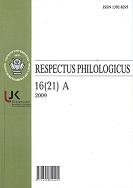LIETUVIŲ BENDRINĖS KALBOS KIRČIUOTŲ ILGŲJŲ IR TRUMPŲJŲ BALSIŲ FORMANTINĖSTRUKTŪRA
THE FORMANT STRUCTURE OF THE AC¬CENTED LONG AND SHORT VOWELS IN LITHUANIAN STANDARD LANGUAGE
Author(s): Robertas KudirkaSubject(s): Language and Literature Studies
Published by: Vilniaus Universiteto Leidykla
Keywords: long and short voices; formant; formant structure; experimental study;
Summary/Abstract: The article aims to describe the instrumental analysis results of the accented long and short vowels in the Lithuanian standard language. In the experiment the formant structure of vowels was investigated. The vowels of the Lithuanian standard language have already been studied and described. However, there are not enough investigations of vowels in linguistic literature. Only dialects are mostly investigated by instrumental methods. The duration of vowels was mostly investigated according to their acoustic features in the past and we have few research works about the formant structure. Mikalauskaitė while schematically depicting the traditional triangle of vowels according to articulating features marked the long vowels and the short vowels on the same line. It is necessary to correct this depiction as the ratio of articulation of long and short vowels is different. There are trapezes of long and short vowels in Pakerys’ book that reflect the articulation features more precisely. There is a trapeze of short vowels inside the trapeze of long vowels, so tenseness is also depicted. However, the trapezes are too ideal (they are given as theoretical model for training purposes). Realistically, we have not such symmetry. The question is whether we could approach any side of short vowels trapeze to the side of long vowels trapeze. To verify those propositions it is necessary to investigate the formant structure of long and short vowels in the Lithuanian standard language and to identify the qualitative differences of long and short vowels. For the analysis, disyllabic words in the Lithuanian standard language, which have the accented monophthong, CV or CVC type on the first syllable, were chosen. For this experiment, 614 words were chosen and recorded – 217 words with circumflex syllabic accents, 159 words with acute syllabic accents and 238 short accented words. It is concluded that the accented long and short vowels in Lithuanian literary language differ very distinctly from the formant structure. The difference between long and short vowels in the formant structure is statistically significant: in all comparable positions circumflex and acute vowels differ from the short vowels with the first and the second formants. Judging from the formant values it can be concluded that long vowels [i,], [u,] and [o,] are of higher tongue rise than short [i], [u] and [û]; long vowels [e,] and [a,] are of more lower rise than short vowels [e] and [a]. By the row long vowels [i,], [e,] are more fronter than short [i], [e]; long vowels [a,], [o,] and [u,] are more back than short vowels [a], [û] and [u].
Journal: Respectus Philologicus
- Issue Year: 2009
- Issue No: 16 (21) A
- Page Range: 141-152
- Page Count: 12
- Language: Lithuanian

